I volunteered to host a very special guest on our farm this month all the way from Kansas! Flat Aggie is part of a super fun and educational school program that introduces classrooms to different sectors of agriculture. We had a lot of fun showing Aggie our farm and this is the report for the classroom to enjoy! If your interested in hosting a Flat Aggie or starting your own program, I can put you in touch with the mastermind behind this project from Tales of a Kansas Farm Mom.
Welcome to Oregon Flat Aggie!
And more specifically the foothills of the Cascade Mountains that border the Eastern side of the Willamette Valley. The area of the Willamette Valley is one of the most agriculturally diverse in the whole nation. On a drive past our neighbors we can see everything from grapes in a vineyard for wine, grass seed, food crops like; corn, beans, peppers, cauliflower, orchards of apples, cherries and hazelnuts, berry fields full of every kind of berry; blueberry, blackberry, marionberry, boysenberry, ornamental flowers, hops for beer, Christmas trees and so many other crops. The Valley’s temperate climate, not too hot in the summer and not too cold in the winter allows for all this variety. But we are a different kind of farm. Oregon is also home to about 350 farm families that do the same thing we do, Dairy Farm!
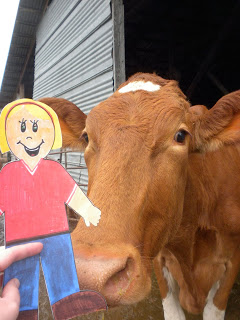 |
| Aggie is greeted by Jen, who requires scratches on her nose and behind her ears! |
On our Dairy Farm, Abiqua Acres, we milk around 85 registered Guernsey cows are brown and white in color and produce milk that is high in protein and butter fat. This rich milk is used to make your favorite products like yogurt, butter and ice cream! First things first I introduced Aggie to the “most important” job on the farm, giving the Ladies their daily dose of love! Each cow is a special individual in our herd and we identify them by name. I think Aggie would have liked to give every cow special scratches, but we had work to do!
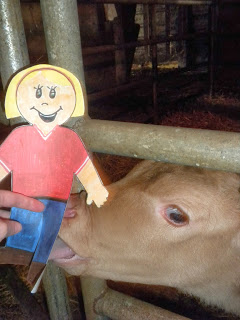 |
| Sunset welcomed Aggie with a big slobbery kiss! |
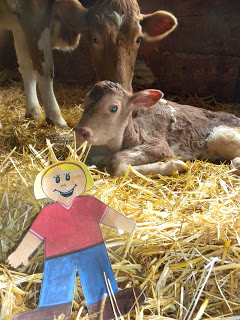 |
| Hello Baby Bull! |
While Aggie was here, we welcomed two new baby calves. Aggie got to meet the bull (boy) calf when he was just a few minutes old. The bull calf will go to another farm to grow up. Aggie helped feed the other new baby a bottle, a heifer (girl) named Sunset. We are always excited to get a heifer calf because we will keep her to grown up and become a milk cow. A big part of our daily chores is the twice a day feeding of all the calves. Currently there are over 40.
Newborns move into individual stalls that we call the nursery, here we can monitor their care closely. They continue to receive milk until they are about 4 months of age. We learned our lesson with Sunset and Aggie stayed a safe distance from curious calf mouths! Besides milk the calves are also fed a special mix of grain that is formulated to help them grow. Once old enough the calves join a group pen of other calves their age. In these pens they are also fed grass hay that we grow and bale here on our farm in the summer.
With all the calves taken care of, Aggie learned just how much you have to feed a producing dairy cow. To make wholesome delicious milk for you and me, a dairy cow will consume a bath tub full of water and eat over 100lbs of food a day. On our farm our cows are fed grain in the parlor where they are milked, and then corn silage and top quality alfalfa hay. Aggie arrived just in time to see our hay barn almost completely full. In the Fall we purchase 350 tons of alfalfa to feed our Ladies through the winter and into the next growing season. These alfalfa bales are 3′ tall, 4′ wide and 8′ long and weigh over 1,500 pounds. To feed them we use a skid steer loader.
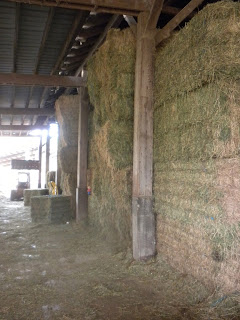 |
| Where’s Aggie? |
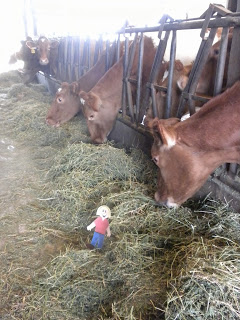 |
| Nom, nom, nom, The Ladies enjoying their alfalfa hay! |
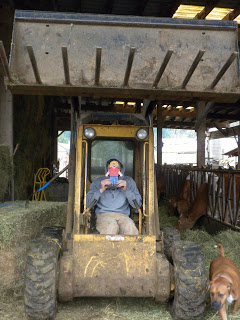 |
| Aggie helped drive the skid steer! |
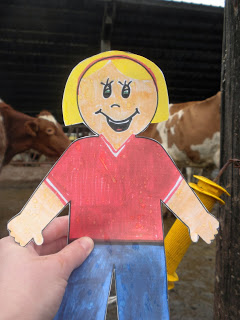 |
| Aggie even got rained on shutting the gate! |
Aggie arrived just as we shut the cows in off of pasture. For as many months as Oregon weather will allow us, our Ladies also rotationally graze fresh green grass from our fields. This is usually from March to about October. This Fall was especially dry so we didn’t close the pasture gate until November!
All that food that dairy cows consume of course goes into their producing milk, and the heart of every dairy farm is the parlor where the cows are milked. Every cow is milked twice a day in one of our six milking stalls in the parlor. Here they enjoy their ration of grain and the relief of being milked. Their teats are washed and dried and then a milking machine is attached. The machine has a sensor that knows when the cow is done and takes the machine off. The milk travels through food grade hoses and then stainless steel pipes to the milk tank where it is cooled. Our milk tank is big enough to hold over 12,000 lbs. Currently every over day the milk truck is picking up over 7,200lbs, that’s over 830 gallons! We sell our milk to Darigold cooperative and after it is on the truck and leaves our farm it is up to them to decide what delicious product to use our cows’ milk in. Milking of the cows takes about 3 hours and the feeding chores about another hour. So just in daily chores we spend 8 hours caring for our cows. That definitely keeps our schedule full and almost makes the days feel longer when we go through the time change in November. It’s dark when we start chores at 4:30 in the morning and dark again when we start chores at 4:30 in the afternoon!
aggie parlor
November is a bit of an “off” season for us, in that the weather slows things down. Besides all the above and more that has to be done every day, twice a day, even Thanksgiving, we find ourselves trying to catch up on some extra projects in the Fall. This year it was replumbing our milking parlor and cutting down some trees in the barnyard that had died. Farmers are also continually expanding their knowledge and Aggie had the chance to join us for a dairy meeting with fellow producers.
We enjoyed having Aggie tag along with us in November! And we hope Mrs. Piatt’s entire class learned a lot about dairy farming in Oregon in the Fall. Here’s a few more facts about dairy farming and November in Oregon:
-Dairy Farming in Oregon-
*Oregon is known for excellent milk and consistently ranks in the top 5 states in the nation for milk quality.
*Milk is Oregon’s official state beverage.
*There is over 120,000 Dairy cows in Oregon, with the average herd size over 350. We are a very small dairy at our herd size of 85!
*Oregon’s most popular breed is Holsteins, with Jersey’s coming in second and other breeds, including Guernseys, making up a small percentage of the rest. The other three breeds represented are Ayrshire, Brown Swiss and Milking Shorthorn.
*Oregon Dairy farmers produce roughly 2.2 billion pounds of milk annually.
-Weather in November in Oregon-
*The daily average high temperature drops at least 10 degrees over the course of November from 57 to 47
*We see an average of over 6 1/2 inches of rain in November.
* Our first “storms” of the season blow in from the Pacific Ocean with high winds and lots of rain.
*We also see our first freezing temperatures
Thanks for Visiting Oregon Aggie!!
help us name them? There are 7 yellow ones, 2 black ones and 2 brown
ones!

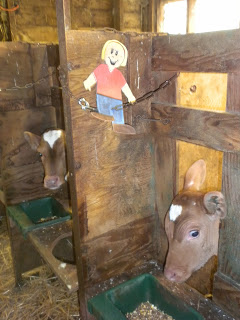
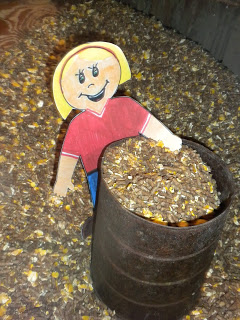
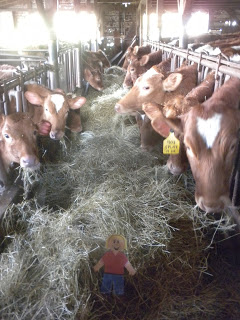
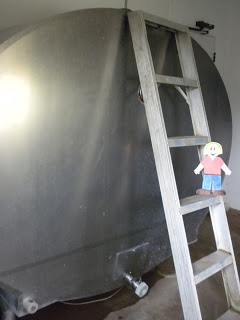
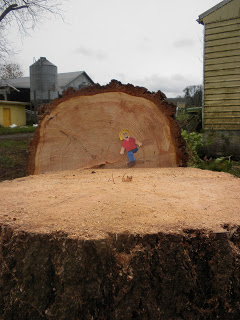
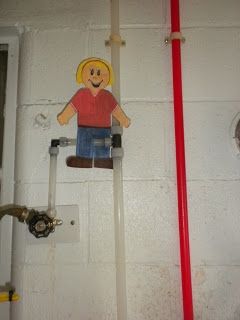
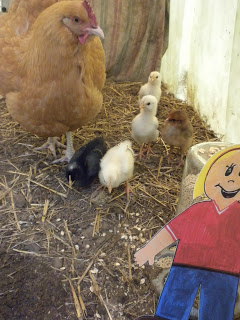
 2017 Year End Review: Farm
2017 Year End Review: Farm I was at the First Thanksgiving
I was at the First Thanksgiving Finding Happiness Through Loss
Finding Happiness Through Loss
Love this, so cute!
I'm sure Aggie would love to visit you!!